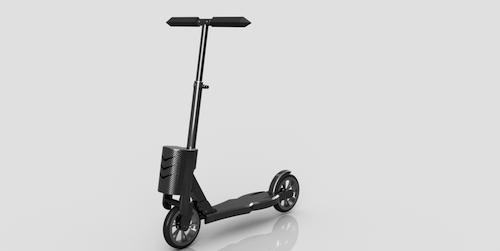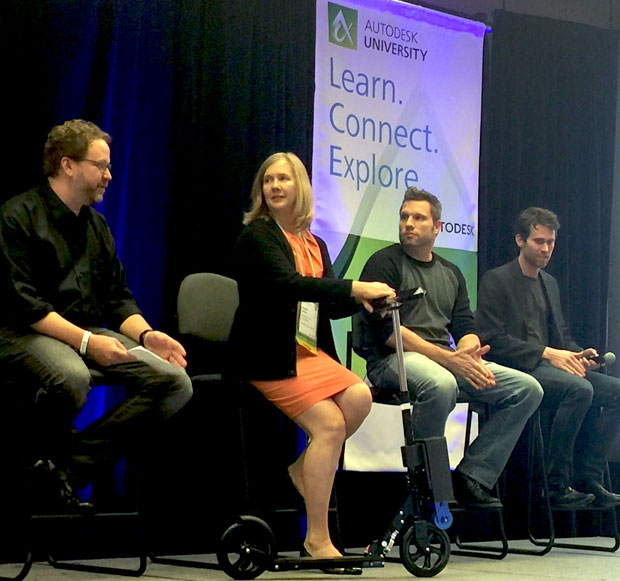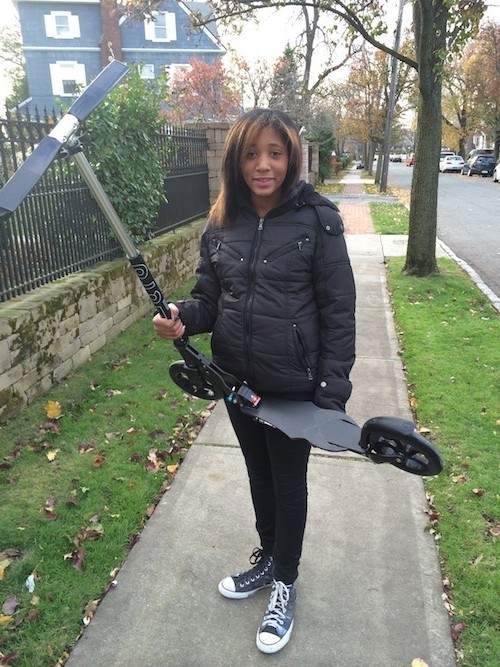
Autodesk Fusion 360 was the principal design tool in Makeosity’s Energy Scooter project. Image Courtesy of Makeosity
Latest News
January 13, 2015
Sure, kids are enamored with their electronic devices, but a cool scooter or bike can also turn heads. Thanks to a program promoting STEM education, a group of middle schoolers were able to turn both interests into a scooter prototype that generates electricity to charge electronic devices while providing a crash course in what it takes to be an engineer.
The Team Makeosity Energy Scooter project, championed by students ages 10 through 13 from PS 107 in the Bronx, got its start as an after-school program empowering students through hands-on projects exploring math and science concepts and basic engineering principles. Dr. Karen Kaun, Makeosity’s founder, got the idea for the scooter project a couple of years ago after reading an article about a soccer ball capable of generating electricity that could be used to power lights in developing countries.
Kaun brought the idea back to her students, who took off designing their first scooter prototype using random parts and materials found around the school. After showcasing the scooter at the 2012 Maker Faire in New York, the students decided they wanted to develop a serious prototype that would not only charge a battery, but an actual electronic device such as a cell phone.
 Autodesk Fusion 360 was the principal design tool in Makeosity’s Energy Scooter project. Image Courtesy of Makeosity.
Autodesk Fusion 360 was the principal design tool in Makeosity’s Energy Scooter project. Image Courtesy of Makeosity.Kaun leveraged connections at Autodesk to get an engineering assist while changing the Makeosity program to a for-profit model that would give the student engineers a stake in the scooter’s future. “I wanted to create an entrepreneurial endeavor that would allows the children to take the ideas and have a chance to see how far they could take something,” she explained. “This endeavor is by and for the children, and they are working towards owning a piece of it.”
Not only are students getting hands-on entrepreneurial experience, they’re also learning the basics about mechanical and electrical engineering and getting tutored in key design tools like CAD and 3D printing. As part of the arrangement with Autodesk, the student team is getting schooled in how to create 3D models with TinkerCAD and Autodesk Fusion 360. Makeosity has also enlisted help building the prototype from engineers at Columbia University and BlackBox Manufacturing in Brooklyn, which is 3D printing parts of the scooter, including the deck and handlebars.
 Dr. Karen Kaun, Makeosity’s founder, took the stage at Autodesk University 2014 to share how students designed the Energy Scooter. The prototype was built with the help of Columbia University and 3D printing from BlueBox Manufacturing.
Dr. Karen Kaun, Makeosity’s founder, took the stage at Autodesk University 2014 to share how students designed the Energy Scooter. The prototype was built with the help of Columbia University and 3D printing from BlueBox Manufacturing.Shakeena Julio, an 8th grader and key member of the Energy Scooter team, says learning to use the Autodesk software has been one of the best parts of the project. “Without the scooter, I would have never been able to use this software,” she said. “Working with the measurements in Fusion has helped me with my math and it’s opened up interests I didn’t know I had.”
Kaun says the next step is to employ Autodesk Fusion 360 to shrink the design, potentially by 75%, and to ready the next prototype by August. Longer term, the idea is to create a scooter design that sells and to employ the electricity-generating engine design on other types of devices.
“If you are bringing a product to market for children, why not do it with children who are really smart and can tell you what they want,” Kaun said.
 Eighth grader Shakeena Julio played a key role in the design of the energy scooter, which generates electricity when ridden to charge electronic devices. Image Courtesy of Makeosity.
Eighth grader Shakeena Julio played a key role in the design of the energy scooter, which generates electricity when ridden to charge electronic devices. Image Courtesy of Makeosity.For Julio, software like Autodesk Fusion 360 is taking her places she wouldn’t otherwise go in a normal school setting. “I didn’t think we could actually make a scooter, but using the software, we did,” she says.
Watch the video below to find out more about the Makeosity program and the Energy Scooter project.
Subscribe to our FREE magazine, FREE email newsletters or both!
Latest News
About the Author
Beth Stackpole is a contributing editor to Digital Engineering. Send e-mail about this article to [email protected].
Follow DE





